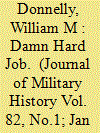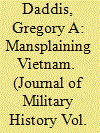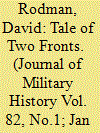|
|
|
Sort Order |
|
|
|
Items / Page
|
|
|
|
|
|
|
| Srl | Item |
| 1 |
ID:
159428


|
|
|
|
|
| Summary/Abstract |
On 9 September 1513 a Scottish army led by King James IV was decisively defeated by an English army, led by Thomas Howard, earl of Surrey. Most recent scholarship on the battle has concentrated on new European-style tactics of the Scots, part of James’s ultimately futile effort to introduce a “Renaissance-style” of kingship. This article re-examines the battle from the English perspective, arguing the English army was more “modern” in terms of its weaponry, tactics, and military organization and, second, that in the person of Thomas Howard they benefitted from the leadership of Britain’s first “Renaissance general.”
|
|
|
|
|
|
|
|
|
|
|
|
|
|
|
|
| 2 |
ID:
159434


|
|
|
|
|
| Summary/Abstract |
James A. Van Fleet believed that units possessing the will to win would always emerge victorious from any battle. From July 1951 to the end of his tenure as Eighth Army’s commander in Korea in February 1953, he would find that his mission of holding the line until an armistice made it difficult to maintain a will to win among U.S. Army infantrymen. Also working against him were factors arising from the Army’s manpower crisis and the tactical problems facing his infantrymen on the battlefield. Under these conditions Van Fleet was unable to keep these units “fit, ready, and eager to fight.”
|
|
|
|
|
|
|
|
|
|
|
|
|
|
|
|
| 3 |
ID:
159429


|
|
|
|
|
| Summary/Abstract |
Previously in the Journal of Military History, Bruce Collins contended that military influences shaped the definition of victory in British colonial campaigns between 1860 and 1882. It is argued that Collins’s examples showed a greater degree of political achievement in their outcome than he suggested. Collins mostly selected successful campaigns for analysis, whereas there were also clear failures in the application of British military power. Even where soldiers defined objectives, they did not necessarily shape the agreements that terminated campaigns. In particular, the example of India’s North West Frontier demonstrated the difficulties of achieving lasting passivity where permanent military occupation was not the objective.
|
|
|
|
|
|
|
|
|
|
|
|
|
|
|
|
| 4 |
ID:
159435


|
|
|
|
|
| Summary/Abstract |
Of the more than 3 million Americans who deployed to Southeast Asia during the United States’ involvement in the Vietnamese civil war, only some 7,500 were women. Thus, it seems reasonable that memoirs, novels, and film would privilege the male experience when remembering the Vietnam War. Yet in the aftermath of South Vietnam’s collapse, Americans’ memory of the war narrowed even further, equating the conflict as a whole to the male combat veteran’s story. This synthetic literary review examines some of the more lasting works sustaining the popular narrative of Vietnam, one that was constructed, in substantial part, by veterans themselves and one in which the male voice reigned supreme.
|
|
|
|
|
|
|
|
|
|
|
|
|
|
|
|
| 5 |
ID:
159430


|
|
|
|
|
| Summary/Abstract |
The First World War (1914–1918) revolutionized warfare in many ways: in addition to new technologies the old and well-known one of maps acquired a crucial role in sharing information, and understanding and controlling the battlefield. This paper advances three main arguments: first, that maps became an integral part of every aspect of warfare; second, that maps became a mindset, a language to understand, rationalize, and share any kind of information; and third, that it is necessary to rethink the concept of the mapmaker and include within it the multitude of soldiers that at any level collected information.
|
|
|
|
|
|
|
|
|
|
|
|
|
|
|
|
| 6 |
ID:
159433


|
|
|
|
|
| Summary/Abstract |
Erwin Rommel is by any standard a mythical figure. He has been the subject of countless studies in English and German. However, the “Italian side of the hill” has been largely neglected, despite the fact that the foundation of the myth around him lies in the North African campaign, where, after all, thousands of soldiers of the Italian army fought alongside the Afrika Korps. This article will provide an Italian view of the “Desert Fox,” using new primary material that provides insights into Italian assessments during the war. A major source is material gathered by way of eavesdropping by British intelligence on Italian officers held as POWs in Cairo and in England.
|
|
|
|
|
|
|
|
|
|
|
|
|
|
|
|
| 7 |
ID:
159436


|
|
|
|
|
| Summary/Abstract |
Caught by surprise by the Syrian and Egyptian armies at the outset of the 1973 Yom Kippur War, the Israel Defense Forces (IDF) experienced serious reverses on both the Golan and Sinai fronts during the early days of hostilities but recovered more quickly in the north than in the south. The Israeli government’s prioritization of the Golan front early in the war and the cumulative effects of at least six other variables—terrain, frontline forces, command and control (C2), reserve mobilization, airpower, and combined arms warfare—explain the IDF’s better performance in the north during the early days of the conflict.
|
|
|
|
|
|
|
|
|
|
|
|
|
|
|
|
| 8 |
ID:
159431


|
|
|
|
|
| Summary/Abstract |
Many military historians have emphasised technological innovation as the defining characteristic of modern “machine age” warfare. This paradigm ignores the central roles that animals have played in twentieth-century wars and fails to recognise that the scale of their exploitation has actually escalated in modernity, largely in response to technological innovation. In short, the military employment of animals on a massive scale is as much a defining characteristic of modern warfare as is mechanisation. Here, the example of the establishment of permanent, regular military dog units, for use in “civilised” warfare, from the 1880s onwards is used to illustrate this point.
|
|
|
|
|
|
|
|
|
|
|
|
|
|
|
|
| 9 |
ID:
159432


|
|
|
|
|
| Summary/Abstract |
The essay at hand covers the operations on the southern flank of the German front in Yugoslavia from October 1944 to April 1945. During this period, the Germans managed to extricate their XXI Mountain Corps from virtual encirclement on two occasions (in Montenegro and the Bosna River Valley) and ultimately reinforce their hard-pressed main line in the Balkans with this battered, but still battle-worthy, formation. This article will provide the reader with a brief description of this little-known campaign and explain the reasons behind what was probably the Yugoslav Partisans’ greatest “lost victory” of the war. The main argument is that such an outcome was largely the result of the Yugoslav leadership’s refusal to award sufficient attention to this sector of the front and the internal political considerations, but also of the German army’s skillfully conducted defense. The article will also dwell on the battlefield effectiveness of both sides, and the Partisans’ efforts to become a regular army in both their outlook and operational manner.
|
|
|
|
|
|
|
|
|
|
|
|
|
|
|
|
|
|
|
|
|